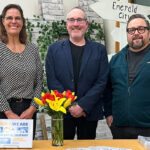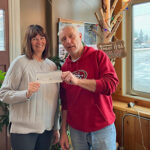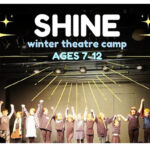Home »

Seventh Salmon Festival flowed deep
By Anne Jardine
On certain rare occasions, the spirit moves. The movement, the moment is beyond explaining, but it is deeply felt.
The Secwepemc/Ktunaxa Salmon Festival’s opening ceremony was such a moment.
 On September 8, at Invermere’s James Chabot Beach, the ceremonial canoes landed to open up the festival. The organizers hoped for this ceremony to be a special welcome for the hundreds of participants, for the invited dignitaries representing federal, provincial, and municipal governments, Parks Canada, BC Hydro, and for the long lost salmon to whose spirit they called.
On September 8, at Invermere’s James Chabot Beach, the ceremonial canoes landed to open up the festival. The organizers hoped for this ceremony to be a special welcome for the hundreds of participants, for the invited dignitaries representing federal, provincial, and municipal governments, Parks Canada, BC Hydro, and for the long lost salmon to whose spirit they called.
The Salmon Festival has been celebrated every September for the past seven years. It has been a popular, colourful cultural event hosted by the Invermere area First Nations, Ktunaxa and Shuswap Band.
This year was different. According to the festival’s coordinator Diana Cote, “We are launching a three nations initiative to bring back the salmon to this great river system. At the Friday night meeting before the festival opened, we had all the government, industry, and First Nation leadership and elders at the table. It was powerful. We were able to express what the loss of the salmon has meant. Out of this expression, I think a profound understanding was reached, and from that, for the first time, we see a real commitment to bring them back.”
 Salmon have not been up this river since 1938, after the building of Grand Coulee Dam. The loss has had drastic implications for all the cultures that once based their primary food system on the salmon. The disappearance of a prime food source was a devastating impact.
Salmon have not been up this river since 1938, after the building of Grand Coulee Dam. The loss has had drastic implications for all the cultures that once based their primary food system on the salmon. The disappearance of a prime food source was a devastating impact.
“Not only has it weakened us culturally and economically,” said Cote, “it has changed us right down to the DNA. There has been ‘something missing.’ For three or four generations, we have been starving for the prime food that was once so much a part of our life. This loss is something that has not really been spoken about. I think understanding that truth was what helped all the leaders come to this new level of commitment to restore the salmon.”
Cote explained, “This is not just a celebration, this is an important work. For seven years we have been introducing and educating, always inviting political people to the festival, and they have mostly attended from courtesy, or to increase their local visibility. This is the first time we have called them to help do the work. For the first time, they are responding to the call. We have agreement that the return of the salmon is a real goal. We have technical people, lands and resources specialists, water stewardship and fisheries specialists, government research departments, industrial researchers from (BC) Hydro, Columbia Power, and Fortis. All these people are at work on the different aspects of this initiative, and also we have our cultural and heritage people looking at it from the historical perspective. And it is important to add that Columbia Basin Trust has supported this work over all its years since the beginning.
 “At the next meeting, later this fall, we will be inviting the technical people to the table with government, and we will be looking for a full detailed agreement and the beginnings of an actual plan. We’ll see what happens. We are hopeful.”
“At the next meeting, later this fall, we will be inviting the technical people to the table with government, and we will be looking for a full detailed agreement and the beginnings of an actual plan. We’ll see what happens. We are hopeful.”
On Saturday morning the invited dignitaries began their journey on the other side of Fort Point at Kinsmen Beach. Before they set out, Chief Alfred Joseph deposited some real salmon roe into the gravel poured some milt over it and spoke of the hopes that this initiative would grow. The three canoes launched into a strong, chilly headwind and the glowering of a rainstorm, and made their way slowly around the point towards James Chabot Beach.
Shuswap Band cultural liaison Shawn Billy helped put together the dance portion of the Salmon Festival’s opening ceremony on Chabot Beach. When the canoe brigade of dignitaries had been drummed in and landed on the beach, and the waiting assembly of about 200 people had been welcomed by Shuswap Chief Barb Cote and Ktunaxa Chief Alfred Joseph, the Salmon Dance began.
Shawn Billy introduced the troupe of drummers and dancers from the Okanagan and Salmon Arm. Neskonith dancer Minnie Kenoras led the procession and taught the children the steps and gestures necessary to become salmon dancers.
Shawn Billy’s three young children joined in and ‘swam’ solemnly and gracefully into the circle. The dancers moved to the edge of the lake, where Minnie reached down and touched the water to call the salmon spirits, then the group ‘swam’ up the gravelly beach, where she reached down and moved the pebbles from side to side as a female salmon deposits her eggs, then the dancers moved across the beach and back to the water, circling four times to symbolize the four year cycle of the salmon.
The drummers kept a steady song going with alternate male and female voices chanting their prayer for the salmon and people on the beach who witnessed the Salmon Dance.
Shawn explained, “This song and dance were taught to me by a friend from the Okanagan area. The dance is a call, it’s a prayer, it’s most importantly a way to show respect.”
Throughout the slow and weaving dance, the clouds danced above and the sun burst through, warming the faces of the participants and gently drying the tears.

Later that afternoon, the festival continued up the hill at the grounds of the Shuswap Band Hall where everyone danced and feasted on salmon brought by a Neskonlith Shuswap group from the famous Adams River run.
There were more dance groups from Cranbrook, from Alberta, and some from as far away as Saskatchewan. The dancing was intricate, the regalia were dazzlingly colourful, the whole day was, in the words of one festival goer, “inclusive, welcoming, and uplifting.”
The organizers were proud. The story continues. The salmon will return.
Band clerk Sierra Stump commented, “This year’s festival was different because we are moving that dream forward.”
Chief Barb Cote added: “I’m so pleased with the way the festival turned out and so appreciative of how hard everybody worked to make it a success!”
Lead image: Paddlers salute before coming ashore at James Chabot Beach. Photos by Anne Jardine









